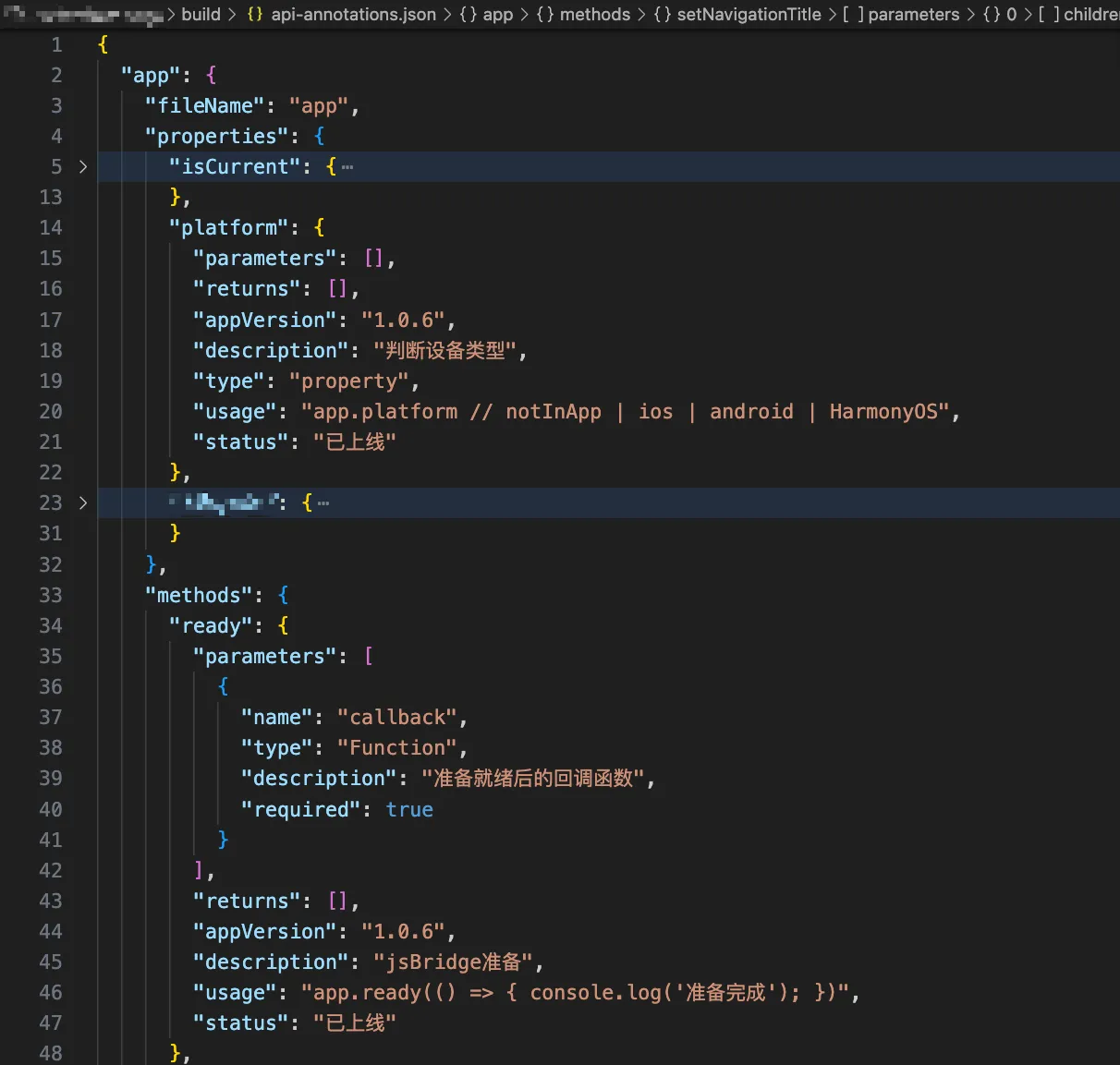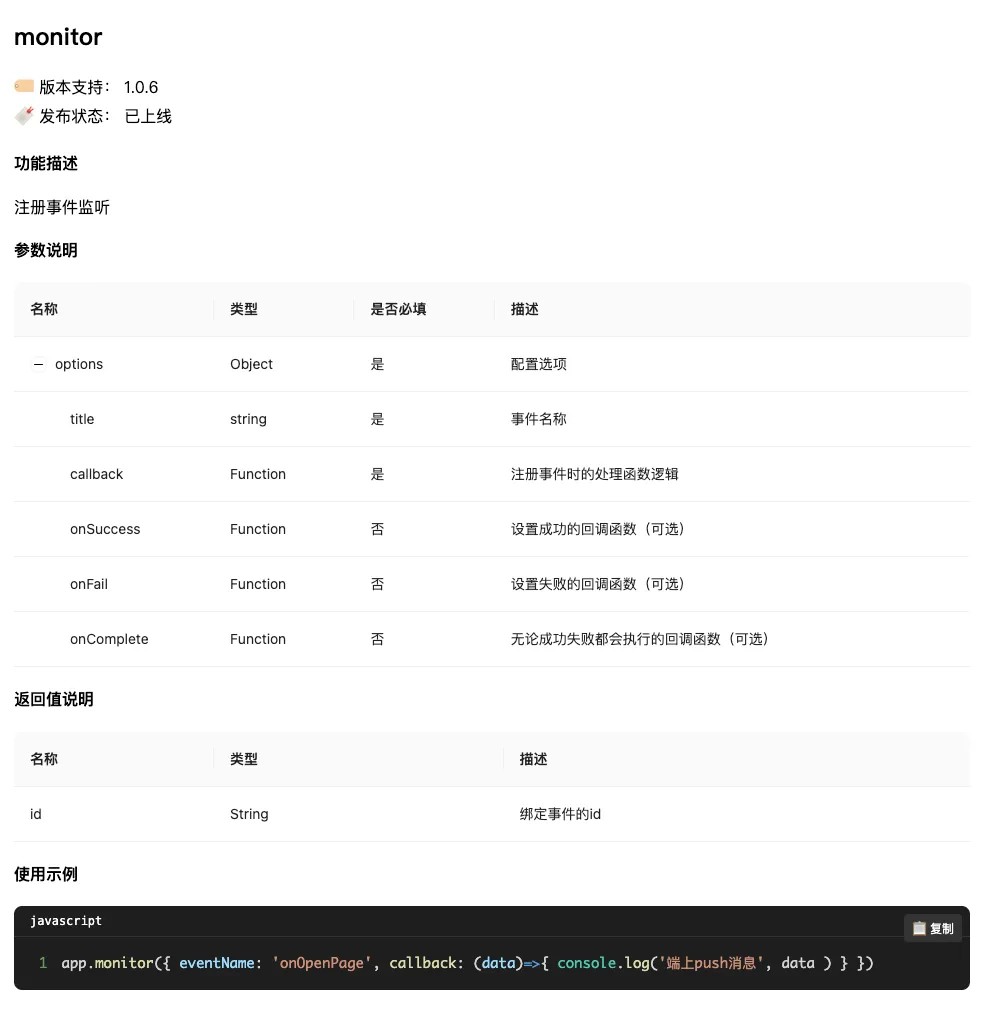项目背景
最近我们团队自研了一个基于 React 的 H5 前端框架,领导让我来负责编写框架的使用文档。我选择了 dumi 来搭建文档站点,大部分内容都是手动写 Markdown 来介绍各种功能,包括:初始化、目录结构、生命周期、状态管理、插件系统 等等。
框架里有个很重要的子包,主要负责多个 App 的桥接能力,深度集成了各端环境的监测和桥接逻辑。这个子包对外提供了一个 App 实例对象,里面封装了很多原生能力,比如: 设置导航栏、录音、保存图片到相册 等
这些 API 代码格式都比较统一,领导希望避免在框架源码和文档里重复定义相同的接口,最好能直接从源代码自动生成文档内容。需要提取的信息包括:API支持的App版本、功能描述、开发状态、使用方式,如果是函数的话还要有参数说明和返回值说明。
我的解决方案
经过一番思考,我想到了一个方案:
核心思路:在不改动源代码逻辑的前提下,通过增加注释信息来补充文档需要的元数据
具体实现路径:
- 定义一套规范的注释标签
- 编写解析脚本提取信息,生成 JSON 文件
- 在文档项目中读取 JSON,动态渲染成 API 文档
定义注释规范
我定义了一系列标准的注释标签:
- @appVersion —— 支持该API的App版本
- @description —— API的功能描述
- @apiType —— API类型,默认是函数,可选property(属性)和function(函数)
- @usage —— 使用示例
- @param —— 函数参数说明(只有函数类型需要)
- @returns —— 函数返回值说明(只有函数类型需要)
- @status —— 发布状态
在实际代码中这样使用,完全不会影响原来的业务逻辑:
const app = {/*** @appVersion 1.0.0* @description 判断设备类型* @apiType property* @usage app.platform // notInApp | ios | android | HarmonyOS * @status 已上线 */platform: getPlatform(),/*** @appVersion 1.0.6 * @description 注册事件监听* @param {Object} options - 配置选项* @param {string} options.title - 事件名称* @param {Function} options.callback - 注册事件时的处理函数逻辑* @param {Function} options.onSuccess - 设置成功的回调函数(可选)* @param {Function} options.onFail - 设置失败的回调函数(可选)* @param {Function} options.onComplete - 无论成功失败都会执行的回调函数(可选)* @usage app.monitor({ eventName: 'onOpenPage', callback: (data)=>{ console.log('端上push消息', data ) } })* @returns {String} id - 绑定事件的id* @status 已上线*/monitor: ({ onSuccess, onFail, onComplete, eventName = "", callback = () => { } }) => {let _id = uuid();// 业务代码省略return _id;},
}
解析脚本
接下来要写一个解析脚本,把注释内容提取成键值对格式,主要用正则表达式来解析注释:
const fs = require('fs');
const path = require('path');/*** 解析参数或返回值标签* @param {string} content - 标签内容* @param {string} type - 类型 ('param' 或 'returns')* @returns {Object} 解析后的参数或返回值对象*/
function parseParamOrReturn(content, type = 'param') {const match = content.match(/{([^}]+)}\s+(\w+)(?:\.(\w+))?\s*-?\s*(.*)/);if (!match) return null;const paramType = match[1];const parentName = match[2];const childName = match[3];const description = match[4].trim();const isParam = type === 'param';if (childName) {// 嵌套参数或返回值 (options.title 或 data.result 格式)return {name: parentName,type: 'Object',description: isParam ? `${parentName} 配置对象` : `${parentName} 返回对象`,required: isParam ? true : undefined,children: [{name: childName,type: paramType,description: description,required: isParam ? (!paramType.includes('?') && !description.includes('可选')) : undefined}]};} else {// 普通参数或返回值return {name: parentName,type: paramType,description: description,required: isParam ? (!paramType.includes('?') && !description.includes('可选')) : undefined};}
}/*** 合并嵌套对象* @param {Array} items - 参数或返回值数组* @returns {Array} 合并后的数组*/
function mergeNestedItems(items) {const merged = {};items.forEach(item => {if (item.children) {// 嵌套对象if (!merged[item.name]) {merged[item.name] = { ...item };} else {// 合并子元素if (!merged[item.name].children) merged[item.name].children = [];merged[item.name].children.push(...item.children);}} else {// 普通参数if (!merged[item.name]) {merged[item.name] = item;}}});return Object.values(merged);
}/*** 保存标签内容到注解对象*/
function saveTagContent(annotation, tag, content) {// 确保 parameters 和 returns 数组存在if (!annotation.parameters) annotation.parameters = [];if (!annotation.returns) annotation.returns = [];switch (tag) {case 'appVersion':annotation.appVersion = content;break;case 'sxzVersion':annotation.sxzVersion = content;break;case 'mddVersion':annotation.mddVersion = content;break;case 'description':annotation.description = content;break;case 'status':annotation.status = content;break;case 'usage':annotation.usage = content.trim();break;case 'apiType':// 解析类型:property 或 methodannotation.type = content.toLowerCase();break;case 'param':const param = parseParamOrReturn(content, 'param');if (param) {annotation.parameters.push(param);// 合并嵌套对象annotation.parameters = mergeNestedItems(annotation.parameters);}break;case 'returns':const returnItem = parseParamOrReturn(content, 'returns');if (returnItem) {annotation.returns.push(returnItem);// 合并嵌套对象annotation.returns = mergeNestedItems(annotation.returns);}break;}
}/*** 解析 JSDoc 注释中的注解信息 - 逐行解析*/
function parseJSDocAnnotation(comment) {if (!comment) return null;const annotation = {};// 按行分割注释const lines = comment.split('\n');let currentTag = '';let currentContent = '';for (const line of lines) {// 清理行内容,移除 * 和首尾空格,但保留内部的换行意图const cleanLine = line.replace(/^\s*\*\s*/, '').trimRight();// 跳过空行和注释开始结束标记if (!cleanLine || cleanLine === '/' || cleanLine === '*/') continue;// 检测标签开始const tagMatch = cleanLine.match(/^@(\w+)\s*(.*)$/);if (tagMatch) {// 保存前一个标签的内容if (currentTag) {saveTagContent(annotation, currentTag, currentContent);}// 开始新标签currentTag = tagMatch[1];currentContent = tagMatch[2];} else if (currentTag) {// 继续当前标签的内容,但保留换行// 对于 @usage 标签,我们保留原始格式if (currentTag === 'usage') {currentContent += '\n' + cleanLine;} else {currentContent += ' ' + cleanLine;}}}// 保存最后一个标签的内容if (currentTag) {saveTagContent(annotation, currentTag, currentContent);}// 确保 parameters 和 returns 数组存在(即使为空)if (!annotation.parameters) annotation.parameters = [];if (!annotation.returns) annotation.returns = [];return Object.keys(annotation).length > 0 ? annotation : null;
}/*** 使用 @apiType 标签指定类型*/
function extractAnnotationsFromSource(sourceCode) {const annotations = { properties: {}, methods: {} };// 使用更简单的逻辑:按行分析const lines = sourceCode.split('\n');for (let i = 0; i < lines.length; i++) {const line = lines[i].trim();// 检测 JSDoc 注释开始if (line.startsWith('/**')) {let jsdocContent = line + '\n';let j = i + 1;// 收集完整的 JSDoc 注释while (j < lines.length && !lines[j].trim().startsWith('*/')) {jsdocContent += lines[j] + '\n';j++;}if (j < lines.length) {jsdocContent += lines[j] + '\n'; // 包含结束的 */// 查找注释后面的代码行for (let k = j + 1; k < lines.length; k++) {const codeLine = lines[k].trim();if (codeLine && !codeLine.startsWith('//') && !codeLine.startsWith('/*')) {// 解析注解const annotation = parseJSDocAnnotation(jsdocContent);if (annotation) {// 从注解中获取类型(property 或 method)let itemType = annotation.type;let name = null;// 如果没有明确指定类型,默认设为 methodif (!itemType) {itemType = 'method';}// 提取名称const nameMatch = codeLine.match(/^(\w+)\s*[:=]/);if (nameMatch) {name = nameMatch[1];} else {// 如果没有匹配到名称,尝试其他模式const funcMatch = codeLine.match(/^(?:async\s+)?(\w+)\s*\(/);if (funcMatch) {name = funcMatch[1];}}if (name) {if (itemType === 'property') {annotations.properties[name] = annotation;} else if (itemType === 'method') {annotations.methods[name] = annotation;} else {console.warn(`未知的类型: ${itemType},名称: ${name}`);}} else {console.warn(`无法提取名称: ${codeLine.substring(0, 50)}`);}}break;}}i = j; // 跳过已处理的行}}}return annotations;
}/*** 从文件提取注解*/
function extractAnnotationsFromFile(filePath) {if (!fs.existsSync(filePath)) {console.error('文件不存在:', filePath);return { properties: {}, methods: {} };}const sourceCode = fs.readFileSync(filePath, 'utf-8');return extractAnnotationsFromSource(sourceCode);
}/*** 提取所有文件的注解*/
function extractAllAnnotations(filePaths) {const allAnnotations = {};filePaths.forEach(filePath => {if (fs.existsSync(filePath)) {const fileName = path.basename(filePath, '.js');console.log(`\n=== 处理文件: ${fileName} ===`);const annotations = extractAnnotationsFromFile(filePath);if (Object.keys(annotations.properties).length > 0 ||Object.keys(annotations.methods).length > 0) {allAnnotations[fileName] = {fileName,...annotations};}}});return allAnnotations;
}module.exports = {parseJSDocAnnotation,extractAnnotationsFromSource,extractAnnotationsFromFile,extractAllAnnotations
};
集成到构建流程
然后创建一个脚本,指定要解析的源文件,把生成的 JSON 文件 输出到 build 目录里:
const { extractAllAnnotations } = require('./jsdoc-annotations');
const fs = require('fs');
const path = require('path');/*** 主函数 - 提取注解并生成JSON文件*/
function main() {const filePaths = [path.join(process.cwd(), './app.js'),path.join(process.cwd(), './xxx.js'),path.join(process.cwd(), './yyy.js'),].filter(fs.existsSync);if (filePaths.length === 0) {console.error('未找到任何文件,请检查文件路径');return;}const annotations = extractAllAnnotations(filePaths);const outputPath = path.join(process.cwd(), './build/api-annotations.json');// 保存为JSON文件fs.writeFileSync(outputPath, JSON.stringify(annotations, null, 2));
}main();
在 package.json 里定义构建指令,确保 build 的时候自动运行解析脚本:
{"scripts": {"build:annotations": "node scripts/extract-annotations.js","build": "(cd template/main-app && npm run build) && npm run build:annotations"},
}
执行效果:运行 npm run build 后,会生成结构化的 JSON 文件:

在文档中展示
框架项目和文档项目是分开的,把 JSON 文件生成到 build 文件夹,上传到服务器后提供固定访问路径。
有了结构化的 JSON 数据,生成文档页面就很简单了。在 dumi 文档里,把解析逻辑封装成组件:
---
title: xxx
order: 2
---```jsx
/*** inline: true*/
import JsonToApi from '/components/jsonToApi/index.jsx';export default () => <JsonToApi type="app" title="xxx" desc="App原生 api 对象"/>;
```
渲染效果如图所示

在将 JSON 数据解析并渲染到页面的过程中,有两个关键的技术点需要特别关注:
要点一:优雅的代码展示体验
直接使用 dangerouslySetInnerHTML 来呈现代码片段会导致页面样式简陋、缺乏可读性。我们需要借助代码高亮工具来提升展示效果,同时添加便捷的复制功能,让开发者能够轻松复用示例代码。
import React from 'react';
import { Prism as SyntaxHighlighter } from 'react-syntax-highlighter';
import { vscDarkPlus } from 'react-syntax-highlighter/dist/esm/styles/prism';const CodeBlock = ({children,language = 'javascript',showLineNumbers = true,highlightLines = []
}) => {const [copied, setCopied] = React.useState(false);// 可靠的复制方法const copyToClipboard = async (text) => {try {// 方法1: 使用现代 Clipboard APIif (navigator.clipboard && window.isSecureContext) {await navigator.clipboard.writeText(text);return true;} else {// 方法2: 使用传统的 document.execCommand(兼容性更好)const textArea = document.createElement('textarea');textArea.value = text;textArea.style.position = 'fixed';textArea.style.left = '-999999px';textArea.style.top = '-999999px';document.body.appendChild(textArea);textArea.focus();textArea.select();const success = document.execCommand('copy');document.body.removeChild(textArea);return success;}} catch (err) {console.error('复制失败:', err);// 方法3: 备用方案 - 提示用户手动复制prompt('请手动复制以下代码:', text);return false;}};const handleCopy = async () => {const text = String(children).replace(/\n$/, '');const success = await copyToClipboard(text);if (success) {setCopied(true);setTimeout(() => setCopied(false), 2000);}};return (<div className="code-container" style={{ position: 'relative', margin: '20px 0' }}>{/* 语言标签 */}<div style={{background: '#1e1e1e',color: '#fff',padding: '8px 16px',borderTopLeftRadius: '8px',borderTopRightRadius: '8px',borderBottom: '1px solid #333',fontSize: '12px',fontFamily: 'monospace',display: 'flex',justifyContent: 'space-between',alignItems: 'center'}}><span>{language}</span><buttononClick={handleCopy}style={{position: 'absolute',top: '8px',right: '8px',background: copied ? '#52c41a' : '#333',color: 'white',border: 'none',padding: '4px 8px',borderRadius: '4px',fontSize: '12px',cursor: 'pointer',zIndex: 10,transition: 'all 0.3s'}}>{copied ? '✅ 已复制' : '📋 复制'}</button></div>{/* 代码区域 */}<SyntaxHighlighterlanguage={language}style={vscDarkPlus}showLineNumbers={showLineNumbers}wrapLines={true}lineProps={(lineNumber) => ({style: {backgroundColor: highlightLines.includes(lineNumber)? 'rgba(255,255,255,0.1)': 'transparent',padding: '2px 0'}})}customStyle={{margin: 0,borderTopLeftRadius: 0,borderTopRightRadius: 0,borderBottomLeftRadius: '8px',borderBottomRightRadius: '8px',padding: '16px',fontSize: '14px',lineHeight: '1.5',background: '#1e1e1e',border: 'none',borderTop: 'none'}}codeTagProps={{style: {fontFamily: '"Fira Code", "Monaco", "Consolas", "Courier New", monospace',fontSize: '14px'}}}>{String(children).replace(/\n$/, '')}</SyntaxHighlighter></div>);
};export default CodeBlock;
要点二:锚点导航方案
由于我们是通过组件方式动态渲染内容,无法直接使用 dumi 内置的锚点导航功能。这就需要我们自主实现一套导航系统,并确保其在不同屏幕尺寸下都能保持良好的可用性,避免出现布局错乱的问题。
import React, { useEffect, useRef } from 'react';
import { Anchor } from 'antd';
export default function readJson(props){const anchorRef = useRef(null);const anchorWrapperRef = useRef(null);useEffect(() => {// 使用更长的延迟确保 DOM 完全渲染const timer = setTimeout(() => {const contentElement = document.querySelector('.dumi-default-content');const anchorElement = anchorRef.current;if (!contentElement || !anchorElement) return;// 创建锚点容器const anchorWrapper = document.createElement('div');anchorWrapper.className = 'custom-anchor-wrapper';Object.assign(anchorWrapper.style, {position: 'sticky',top: '106px',width: '184px',marginInlineStart: '24px',maxHeight: '80vh',overflow: 'auto',overscrollBehavior: 'contain'});// 插入到内容元素后面if (contentElement.nextSibling) {contentElement.parentNode.insertBefore(anchorWrapper, contentElement.nextSibling);} else {contentElement.parentNode.appendChild(anchorWrapper);}// 移动锚点anchorWrapper.appendChild(anchorElement);// 记录锚点容器,用于清理anchorWrapperRef.current = anchorWrapper;}, 500); // 500ms 延迟,确保 DOM 完全渲染return <div ref={anchorRef}><AnchortargetOffset={80}items={[{key: 'properties',href: '#properties',title: '属性',children: Object.keys(properties).map(item => ({key: item,href: `#${item}`,title: item}))},{key: 'methods',href: '#methods',title: '方法',children: Object.keys(methods).map(item => ({key: item,href: `#${item}`,title: item}))}]}/></div>
}
当然,在页面功能上我们还可以进一步丰富,比如增加实用的筛选功能。比如快速查看特定 App 版本支持的 API、筛选"已上线"、"开发中"或"已废弃"的接口,这些筛选能力让文档不再是静态的参考手册,而变成了一个API 探索工具,最终呈现效果如下:

通过这套自动化文档方案,我们实现了代码和文档的实时同步,大大减少了维护成本,同时给开发者提供了出色的使用体验。现在开发同学只需要在代码里写好注释,文档就会自动更新,再也不用担心文档落后于代码了。
如果你对前端工程化有兴趣,或者想了解更多前端相关的内容,欢迎查看我的其他文章,这些内容将持续更新,希望能给你带来更多的灵感和技术分享~
